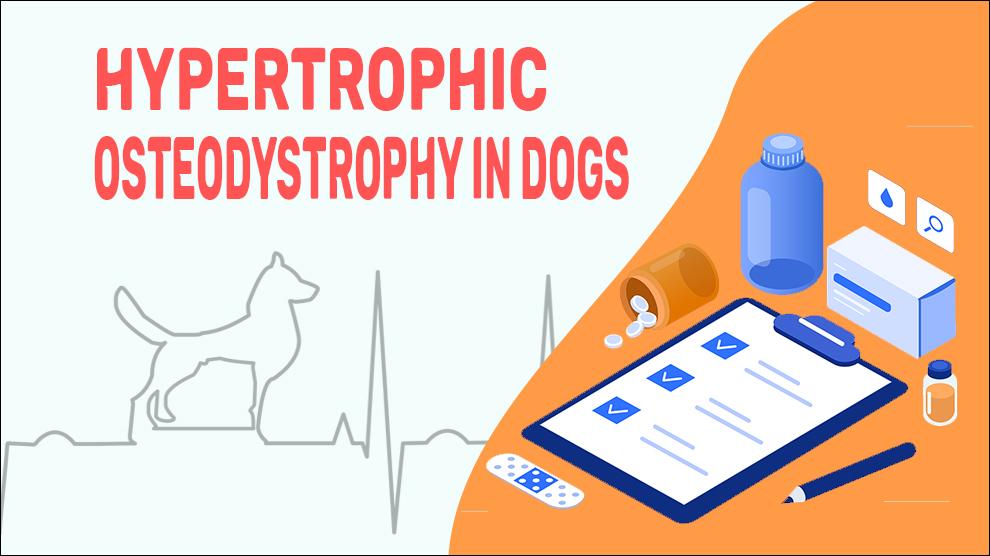What Is Hypertrophic Osteodystrophy In Dogs?
Hypertrophic Osteodystrophy (HOD) is an auto-inflammatory, orthopedic, developmental disorder of the long bones of large and giant-breed dogs (usually between 2 -8 months of age). The incidence has not been established exactly, but luckily, the condition is self-limiting. That is to say, the bone growth ceases or even regresses as the symptoms usually resolve within one year of age.
This is also called metaphyseal osteodystrophy or scurvy. Unfortunately, both names are confusing as the initial lesion is fibrinous osteomyelitis and suppurative lesion of the trabecular bone of the metaphysis (flared regions of long bones). The formation of abundant periosteal new bone replaces this in the chronic stages of the disease.
Exacerbations/ Remissions may occur over weeks to months. If the pain can be managed successfully, most cases resolve completely. While the initial lesion is considered inflammatory, causative agents have not been properly identified.
HOD is characterized by retarded bone resorption and excessive bone deposition. The long bones including the radius, ulna, humerus, tibia, and femurs are the most commonly affected; any/all limbs can be affected intermittently or all at once. The cause and pathogenesis are poorly understood; the condition is not caused by an excessive vitamin D or deficiency of vitamin C or any other dietary minerals.
Symptoms Of Hypertrophic Osteodystrophy In Dogs
Treatment Options For Hypertrophic Osteodystrophy In Dogs
The treatment protocol for HOD in dogs focuses on management rather than cure. Treatment protocol focuses on curtailing pain while increasing your dog's function and lifestyle.
Bone growth optimization: Avoiding calcium supplementation by managing food consumption.
Nutritional supplementation: Omega-3 fatty acids and undenatured collagen.
- Maintaining a healthy weight: Clinical studies demonstrate that ideal weight decreases the rate of arthritic progression in dogs.
- Pain management:
- Nonsteroidal anti-inflammatory drugs (NSAIDs).
- Amantadine- brand names- Osmolex ER, Gocovri, Endantadine and Symmetrel.
Home Remedies For Hypertrophic Osteodystrophy In Dogs
Hypertrophic Osteodystrophy condition is not improved by conventional treatment. So apart from treatment, discuss with a veterinarian any home care specific to your dog’s situation.
How To Prevent Hypertrophic Osteodystrophy In Dogs?
HOD pathogenesis is still unclear. Prevention is not possible for HOD as the causes in dogs is varied. There’s not much a pet owner can do to prevent them as Hereditary is a factor in some breeds but a high-quality diet with bone supplements may help somehow or other.
Affected Dog Breeds Of Hypertrophic Osteodystrophy
Large Breed Dogs, Giant Dog Breeds, Great Dane, Saint Bernard, Boxer, Chesapeake Bay Retriever, Irish Setter, German Shepherd, Labrador Retriever
Causes, Diagnosis, And Prognosis For Hypertrophic Osteodystrophy In Dogs
1. Causes:
- Genetics
- Irrespective of the possibility of bacterial or viral involvement, it's widely held that this is condition is of genetic origin
2. Morbidity:
An underlying genetic defect is said to cause HOD with varying degrees of clinical expression, ranging from simple to severe, recurring infections. Interestingly, metaphyseal osteopathy is developed in 90% of these dogs by 10- 12 weeks of age and for resolution of all these lesions, hematopoietic stem cell transplants are used. So, it’s been speculated that entrapment of neutrophils at metaphysis chondro-osseous junction (same location for the development of osteomyelitis in puppies) causes auto-inflammation and necrosis. The periosteal proliferation is considered to be a secondary event.
3. Mortality:
There is no evidence of HOD alone affecting the dog’s life span.
4. Diagnosis:
- X-rays
- Blood tests to rule out infection
5. Prognosis:
The prognosis depends on the severity of proliferation of the trabecular bone of the metaphysis. Prognosis is usually good as this is a self-limiting disease.
When To See A Vet For Hypertrophic Osteodystrophy In Dogs?
Contact your vet right away, if you notice any of the following:
- Painful swelling of long bones
- Thickening of the pads of the feet
Food Suggestions For Hypertrophic Osteodystrophy In Dogs
- Bland diet: Cooked rice, boiled chicken, low-fat cottage cheese, tofu, canned tuna, boiled hamburger, etc.
- Semi-moist pet food with boiled chicken or Meat-flavored baby food.
- Lean protein: Chicken, lean beef, turkey.
- Dark-green, leafy vegetables like spinach,broccoli, watercress, salad greens, parsley, etc.
- Fatty fish: Tuna, salmon, sardines, mackerel, etc.
- Antioxidant-packed fruits: Blueberries, cherries, cantaloupe, peeled apple.
Conclusion
When your dog's bones have asymmetric swellings, a trip to the vet may be necessary.
Head to the vet only if: The swelling gets worse.
Although the condition is usually benign and self-limiting, it is better to get recommendations from a veterinary orthopedist. There are no reported neurological or behavioral problems.

















